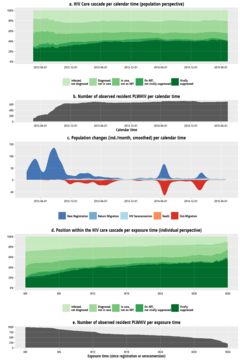Authors
Joseph Larmarange, Collins Iwuji, Joanna Orne-Gliemann, Nuala McGrath, Mélanie Plazy, Kathy Baisley, Till Barnighäusen, François Dabis, Deenan Pillay for the ANRS 12249 TasP Study Group
Ressources
Abstract
Background
Universal test and treat (UTT) could substantially improve the HIV care cascade at population level (i.e. the proportion of all HIV-infected people being diagnosed, on ART and virally suppressed at a given date) and thus reduce HIV incidence. Several trials are currently exploring this hypothesis.
Due to demographic change, the study population of HIV-infected individuals is composed of people with various degrees of exposure to the trial interventions. This structural effect could potentially dilute the impact observed at population level of a UTT strategy. Here, we describe a dynamic cascade according to both calendar (population) and exposure (individual) time approaches, using preliminary data from the ANRS 12249 TasP cluster-randomized trial ongoing in rural KwaZulu-Natal (South Africa).
Methods
Analysis was conducted within a subgroup of 4 clusters with the longest follow-up time where five six-monthly rounds of home-based HIV testing had been conducted between March 2012 and July 2015. Resident members 16 years and above were offered rapid HIV testing and asked to provide dried blood spots (DBS) each time. Those ascertained HIV-positive were referred to local trial clinics for ART initiation and follow-up.
HIV tests results and information on clinic visits, ART prescription, viral load and CD4 count, migration and death were used to calculate residency status, HIV status and HIV care status for each individual on each calendar day. This calendar cascade was then compared to the exposure cascade, where each status was recalculated for individuals at any given date with exposure time defined as the duration since trial registration.
Results

According to calendar time, the overall cascade improved rapidly during the first 15 months of the trial (from 25 to 40% virally suppressed), but more slowly thereafter (Fig a). Although the target population size of HIV-infected people remained rather stable over time ( 665 individuals, Fig b), population turnover was high (Fig c). According to exposure time, with a decreasing sample size over time (Fig e), the cascade improved continuously between M0 and M30, from 20% to 50% virally suppressed (Fig. d).
Conclusions
Population mobility dilutes the observed impact of UTT interventions on the cascade at population level. These preliminary findings also suggest that the impact of a UTT approach could be maximized as long as there is a coordination to facilitate continued access to care when people move.
Reference
Larmarange Joseph, Iwuji Collins, Orne-Gliemann Joanna, McGrath Nuala, Plazy Mélanie, Baisley Kathy, Bärnighausen Till, Dabis François, Pillay Deenan and ANRS 12249 TasP Study Group (2016) “Measuring the Impact of Test and Treat on the HIV Cascade: the Challenge of Mobility” (communication orale), presented at the Conference on Retroviruses and Opportunistic Infections (CROI), Boston. http://www.croiwebcasts.org/console/player/29736.